The post Before a Disaster: Plan for Your Pets appeared first on Friends of the Palo Alto Animal Shelter.
]]>Most of us who are paying attention already have our family emergency kit organized. Water, food supplies, toilet and hygiene items, warm clothes, blankets etc. But what about our pets?
We must ask ourselves – will the dog and cat come with us if we have to leave the house for our own safety? If we must go to a shelter that doesn’t allow animals, will they have to remain in our house, garage? If not, what shelter can they go to, how will they be cared for? Do I have a backup plan for caring for my pet? How will I find them afterward?
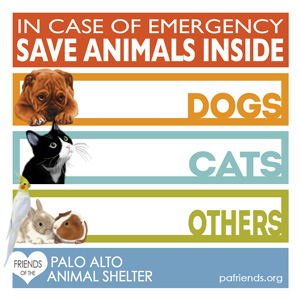
First step: Get a Rescue Alert Sticker
FoPAAS made this sticker for your home. This easy-to-use sticker will let people know that pets are inside your home. Make sure it is visible to rescue workers. Come and get your free sticker at our table at Downtown Farmer’s Market.
Remembering most of the city workers, the fire and police we depend on to help us in time of trouble, will not be able to reach us – most live in other cities. If roads and bridges are down, how will they get here? We should expect to be on our own for up to 5 days after the event.
We should be prepared for all possibilities. Have a kit set up, preferably a crate or other carrier where you can place your pet quickly. Have all his documents, including his vet’s name, any special health concerns, meds, and also a photo of you with your pet for identification purposes. Most people have their pets micro-chipped but make sure that crate contains an extra leash and collar with his tags.
Here is a list of items that should be included in the pet carrier, including the Pet Emergency First Aid Kit.
This should be ready and stored in an easily accessible location.
- Crate with soft clean bedding
- Food – kibble, cans with easy open tops and dishes for food and water
- Gallon jug of water with screw on top
- Cat litter pan and litter
- Doggie bags, newspapers, paper towels
- Current photo of you with your pet to help identification if separated
- Name and number of your vet and any medical conditions. I.e.: diabetic animal requiring shots
- Meds and med records stored in waterproof envelope
- Extra leash and collar or harness
- Booties to protect little feet from broken glass
- A small familiar toy to comfort the animal
- Pets should always be wearing collars with all up to date tags
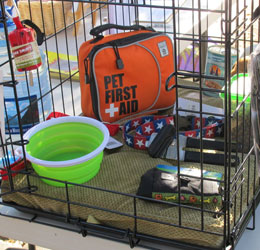
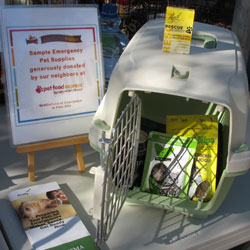
Very important to remember: any catastrophic event is hard on your pet. The sounds, the energy, your own fear, is recognized by the animal and they will be as traumatized just as we are. We must make an effort to calm their fears, create as much normalcy for them as possible, while taking care of all the members of your family.
Pet Emergency First Aid Kit
- First aid manual for pets
- Exam gloves
- First aid tape
- Tweezers
- Blunt tip Scissors
- 4 gauze pads 7x7cm
- 4 gauze pads 5x5cm
- 3 gauze rolls
- Saline Solution
- 8 Antiseptic Wipes
- 2 Wooden Tongue Depressors
- Reusable Woven Cloth Triangle Bandage
- Instant Cold Pack
- 2 Patch Adhesive Bandages
- Elastic Bandage
- Emergency Blanket
 About the Author
About the AuthorJeremy Lindston Robinson, our Vice President
Photo Credit: The U.S. Army
The post Before a Disaster: Plan for Your Pets appeared first on Friends of the Palo Alto Animal Shelter.
]]>The post Enthralling, Exemplary, Elegant Ebony Cats appeared first on Friends of the Palo Alto Animal Shelter.
]]>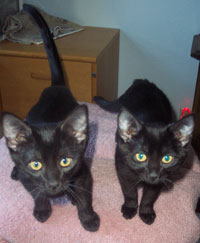 There’s a life-threatening plague sweeping the nation this very moment: the Black Cat Syndrome. It’s causing humans the deprivation of cuddly companions and is even more life-threatening to the furry felines.
There’s a life-threatening plague sweeping the nation this very moment: the Black Cat Syndrome. It’s causing humans the deprivation of cuddly companions and is even more life-threatening to the furry felines.
Mischievous misconceptions concerning not only black cats, but black animals in general, are actually causing the deaths of many healthy shelter animals. On the bottom of adoption lists, and thus on the top of the euthanasia lists of overcrowded shelters, are black cats. But what ridiculous rumors are preventing these black beauties from attracting prospective adopters who are looking for a loving friend? And do these rumors have any ground?
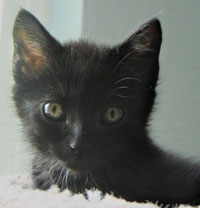 The old saying that a black cat crossing your path bodes bad luck is actually not that old at all. It’s only about as old as the United States, which, compared to other civilizations, is relatively young. In fact, in almost every other country, there’s an even older saying: black cats bring good luck. The Egyptians, for example, worshipped the black cat goddess Bast. In Europe, a black cat crossing your path bodes well for the fortunate pedestrian, while a black cat walking in to your house is a true blessing. The English believe that black cats bring safe seafaring to fishermen, and
The old saying that a black cat crossing your path bodes bad luck is actually not that old at all. It’s only about as old as the United States, which, compared to other civilizations, is relatively young. In fact, in almost every other country, there’s an even older saying: black cats bring good luck. The Egyptians, for example, worshipped the black cat goddess Bast. In Europe, a black cat crossing your path bodes well for the fortunate pedestrian, while a black cat walking in to your house is a true blessing. The English believe that black cats bring safe seafaring to fishermen, and 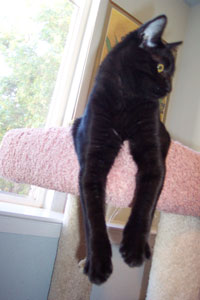 King Charles I’s luck only ran out when his beloved black cat died. In Japan, a black maneki-neko (beckoning cat) signifies good health. Black cats, with their mysterious coloring, only incurred the skepticism of the overcautiously suspicious Pilgrims. They linked black cats with witches, not unlike the black silhouettes on the back of witches’ broomsticks we picture today. But just because the silhouette is black, who’s to say that the cat is black as well? It could be a tabby cat, or a calico cat, or even a pearl-white cat perched on that stick, for all we know. All their silhouettes look exactly the same. And as for cats being associated with witches, I’ve heard many a spell that includes cat’s brains, or cat’s eyes, or cat’s tails; I don’t think cats like being around witches and their cauldrons more than anybody else.
King Charles I’s luck only ran out when his beloved black cat died. In Japan, a black maneki-neko (beckoning cat) signifies good health. Black cats, with their mysterious coloring, only incurred the skepticism of the overcautiously suspicious Pilgrims. They linked black cats with witches, not unlike the black silhouettes on the back of witches’ broomsticks we picture today. But just because the silhouette is black, who’s to say that the cat is black as well? It could be a tabby cat, or a calico cat, or even a pearl-white cat perched on that stick, for all we know. All their silhouettes look exactly the same. And as for cats being associated with witches, I’ve heard many a spell that includes cat’s brains, or cat’s eyes, or cat’s tails; I don’t think cats like being around witches and their cauldrons more than anybody else.
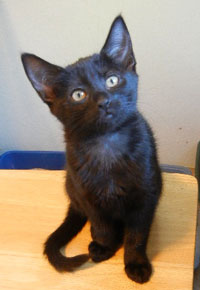 But aside from silly superstitions, there are other misconceptions haunting black cats. Perhaps due to the common image of black silhouettes of cats slinking around in the dead of night (again, a black silhouette does not always translate into a black cat), people often view black cats as shy, and prone to aggression (thanks to plastic black cats with raised hackles decorating trick-or-treaters’ yards). Almost one fourth of the 167 cats I have fostered have been black cats, and I can vouch for every single one of them. Although black cats, like any other cat, can start out shy when first rescued, the black cats I have known have been especially resilient. In fact, I would readily argue that black cats are the second most friendly type of cats (behind the widely accepted friendly orange tabby). That’s not to say that only black cats are friendly; but I have found that, generally speaking, black cats make great family pets. They seem to be particularly gentle with younger children, and are often affectionate lap cats with rumbling purrs. They certainly aren’t more prone to shyness or aggression than any other cat with any random fur coloring. Black cats are as fun-loving and friendly as any other cat, if not more so. On top of all that, scientists have found that the gene pattern related to black coloring might be linked to resistance to pathogens. So, black cats are healthier cats!
But aside from silly superstitions, there are other misconceptions haunting black cats. Perhaps due to the common image of black silhouettes of cats slinking around in the dead of night (again, a black silhouette does not always translate into a black cat), people often view black cats as shy, and prone to aggression (thanks to plastic black cats with raised hackles decorating trick-or-treaters’ yards). Almost one fourth of the 167 cats I have fostered have been black cats, and I can vouch for every single one of them. Although black cats, like any other cat, can start out shy when first rescued, the black cats I have known have been especially resilient. In fact, I would readily argue that black cats are the second most friendly type of cats (behind the widely accepted friendly orange tabby). That’s not to say that only black cats are friendly; but I have found that, generally speaking, black cats make great family pets. They seem to be particularly gentle with younger children, and are often affectionate lap cats with rumbling purrs. They certainly aren’t more prone to shyness or aggression than any other cat with any random fur coloring. Black cats are as fun-loving and friendly as any other cat, if not more so. On top of all that, scientists have found that the gene pattern related to black coloring might be linked to resistance to pathogens. So, black cats are healthier cats!
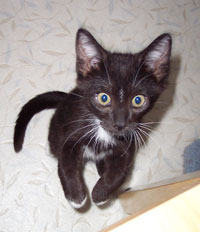 Another aspect that deters prospective adopters away from black cats is poor advertising photos. Black cats can be hard to photograph because they do blend into shadows, and their cute facial features are often lost due to lack of color variation and contrast. This problem, however, has an easy fix. As a shelter cat photographer, positioning the cat against a light background and allowing in lots of natural light highlights the glossy sheen of their alluringly ebony coats, while also allowing for some contrast that brings out their adorable faces. (If you’re an avid photographer with a high-quality camera and some spare
Another aspect that deters prospective adopters away from black cats is poor advertising photos. Black cats can be hard to photograph because they do blend into shadows, and their cute facial features are often lost due to lack of color variation and contrast. This problem, however, has an easy fix. As a shelter cat photographer, positioning the cat against a light background and allowing in lots of natural light highlights the glossy sheen of their alluringly ebony coats, while also allowing for some contrast that brings out their adorable faces. (If you’re an avid photographer with a high-quality camera and some spare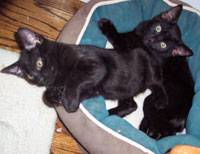 time, consider volunteering at your local animal shelter and help some black cats attract loving forever homes!) As a prospective adopter, realizing this little difficulty when browsing through online photos can help you keep an open mind. Try not to judge the cat solely on the picture (it’s not their fault the photographer didn’t ask for their good side!), but rather on their written personality biographies. Better yet, go to the shelter and see how cute black cats are in person.
time, consider volunteering at your local animal shelter and help some black cats attract loving forever homes!) As a prospective adopter, realizing this little difficulty when browsing through online photos can help you keep an open mind. Try not to judge the cat solely on the picture (it’s not their fault the photographer didn’t ask for their good side!), but rather on their written personality biographies. Better yet, go to the shelter and see how cute black cats are in person.
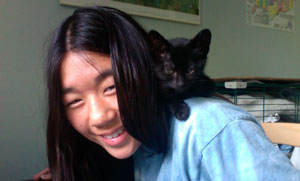 With Halloween coming up, black cats are especially vulnerable. Some organizations even stop adopting out black cats during October, for fear of people buying them just to set them lose on Halloween to scare young trick-or-treaters. Please be considerate during Halloween festivities: try to refrain from scary black cat decorations (stick with ginormous spiders — they’re actually scary!), and please keep your black cat indoors on Halloween if you don’t already always keep your cat within the safety of your home.
With Halloween coming up, black cats are especially vulnerable. Some organizations even stop adopting out black cats during October, for fear of people buying them just to set them lose on Halloween to scare young trick-or-treaters. Please be considerate during Halloween festivities: try to refrain from scary black cat decorations (stick with ginormous spiders — they’re actually scary!), and please keep your black cat indoors on Halloween if you don’t already always keep your cat within the safety of your home.
And if you’re looking for an enthralling, exemplary, elegant furry friend to brighten up your home, please consider an ebony cat! (Click here to see ebony cats up for adoption at PAAS!)
 About the Author
About the AuthorJoanna Tang, our Youth Board Liaison from Gunn High Scool
The post Enthralling, Exemplary, Elegant Ebony Cats appeared first on Friends of the Palo Alto Animal Shelter.
]]>The post All Hail the Noble Pumpkin appeared first on Friends of the Palo Alto Animal Shelter.
]]> Pumpkin season is almost here and with it a scrumptious addition to your dog or cat’s diet: pureed pumpkin. Not pumpkin pie filling with all those yummy spices—just plain old pumpkin.
Pumpkin season is almost here and with it a scrumptious addition to your dog or cat’s diet: pureed pumpkin. Not pumpkin pie filling with all those yummy spices—just plain old pumpkin.
There is something in pumpkin that cures what ails you; good for everything—sort of like Grandma’s lye soap. Pumpkin added to your pet’s food keeps them regular. It helps with indigestion and upset stomachs. It treats diarrhea and constipation with equal effectiveness.
Dogs love pumpkin, and added to their meal, it fills them up and gives them a satisfied feeling. You find pumpkin as an ingredient in high quality kibble for good reason.
If your dog is little on the hefty side, this is the answer! Reduce a portion of their regular food and replace it with the same portion of pumpkin. (A half cup is only 40 calories.) They will thank you for the tasty treat mixed with their boring kibble. A few teaspoons a day for little doggies and pups; a couple of tablespoons for the bigger dogs.
Though cats can be more finicky, they usually love pureed pumpkin, too. I know a cat who likes to lick the spoon used to add pumpkin to the dog’s dish.
Unsalted, roasted pumpkin seeds (called “pepitas”) are high in essential fatty acids and antioxidants, which are good for healthy skin and fur. The oils of the pumpkin flesh and seeds support urinary health. Pumpkin is a great source of Vitamin A, beta-carotene, potassium and iron and can even reduce the likelihood of cancer. And that’s it—the miracle of the noble pumpkin.
 About the Author
About the AuthorJeremy Lindston Robinson, our Vice President
Photo Credit: Scottie Zimmerman; jelene via Compfight cc
The post All Hail the Noble Pumpkin appeared first on Friends of the Palo Alto Animal Shelter.
]]>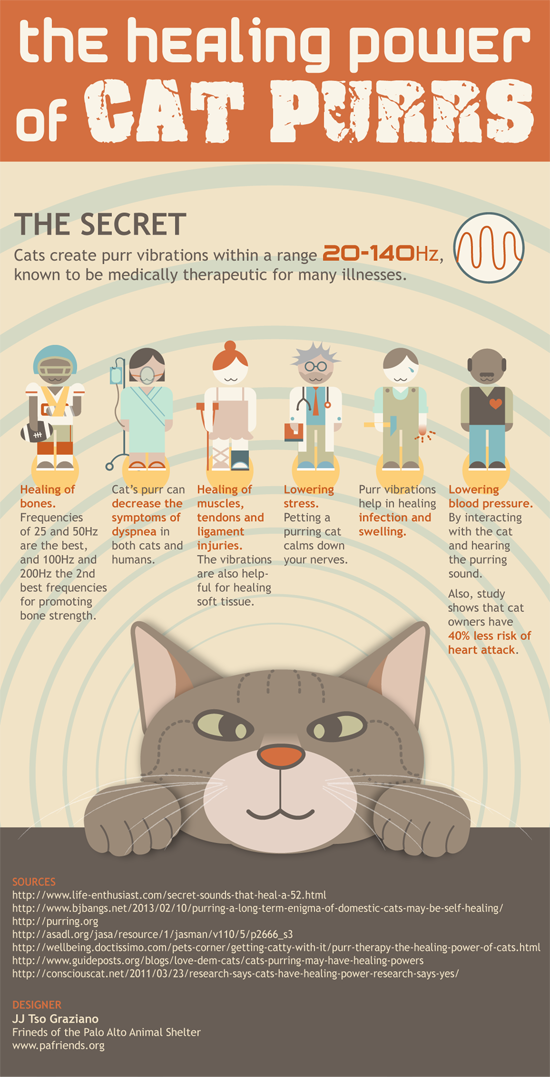
 About the Author
About the AuthorJJ Tso, our Director
The post The Healing Power of Cat Purrs appeared first on Friends of the Palo Alto Animal Shelter.
]]>The post The Cat Who Loves Leaves appeared first on Friends of the Palo Alto Animal Shelter.
]]>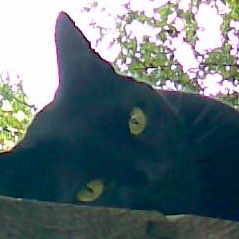 In 2003, my mother and I adopted two kittens from PAAS. We named them Hal and Grady. In 2006, Hal began a practice he continues to this day: during the night he picks up leaves (mostly dried & brown) and brings them home as gifts. He usually drops them on the kitchen floor.
In 2003, my mother and I adopted two kittens from PAAS. We named them Hal and Grady. In 2006, Hal began a practice he continues to this day: during the night he picks up leaves (mostly dried & brown) and brings them home as gifts. He usually drops them on the kitchen floor.
Hal’s leaves are selected and retrieved from our neighbors’ yards, from trees and shrubs we don’t have in our garden. That means he travels over 5-foot fences carrying the leaves and then brings them safely through our cat door. Dry, brittle leaves make it in one piece.
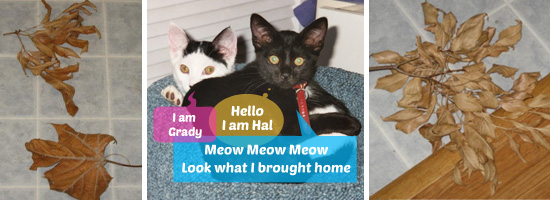
I collected and photographed many of Hal’s gifts. (The apple is to show scale.)
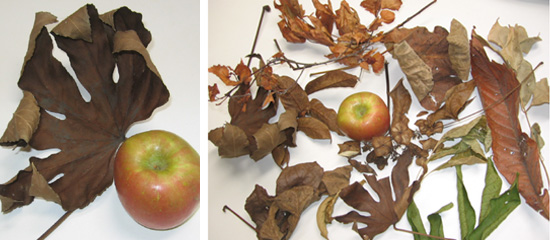
In 2008 I spent six days in the hospital  for back surgery. The first night I returned home, I slept in a downstairs “guest” room. All the animals were pleased at my return, of course. But after dark Hal went out of his way, bringing bunch after bunch of green leaves into the house and dropping them like a trail of breadcrumbs along the hall that leads from the kitchen to the bedroom where I slept. A tangible, verifiable “Welcome Home!” from a cat.
for back surgery. The first night I returned home, I slept in a downstairs “guest” room. All the animals were pleased at my return, of course. But after dark Hal went out of his way, bringing bunch after bunch of green leaves into the house and dropping them like a trail of breadcrumbs along the hall that leads from the kitchen to the bedroom where I slept. A tangible, verifiable “Welcome Home!” from a cat.
The other thing Hal does as he’s returning with leaves is meow. He meows loudly and repeatedly, continuing even after he’s inside the house. In summer with the windows open, I hear him and respond with a comparable “meow.” I think he appreciates the back & forth. Who knows what the neighbors think?
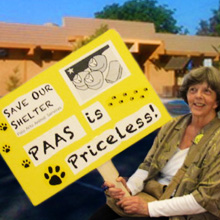 About the Author
About the AuthorScottie Zimmerman, our President
The post The Cat Who Loves Leaves appeared first on Friends of the Palo Alto Animal Shelter.
]]>The post Buster Posey appeared first on Friends of the Palo Alto Animal Shelter.
]]>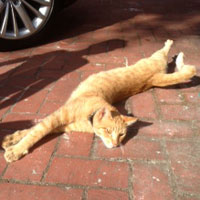 My family adopted a sweet Orange Tabby from Palo Alto Animal Services in 2010. The day we were able to bring our cat home the Giants were in the World Series, so we decided his name had to be Buster Posey. Buster is a very loyal, loving cat with lots of character. Buster loves his family and especially my son, Jake. When Jake is outside playing, Buster Posey follows him where ever he goes, participating in the two square or basketball game, which essentially means lying right in the middle of the court. He has very little fear of being trampled by feet or hit with the ball, which happens from time to time. He will chase a stray ball down the street as if to make sure it doesn’t get too far away from my son and his friends. He loves children and loves to be petted by any child who walks by the house.
My family adopted a sweet Orange Tabby from Palo Alto Animal Services in 2010. The day we were able to bring our cat home the Giants were in the World Series, so we decided his name had to be Buster Posey. Buster is a very loyal, loving cat with lots of character. Buster loves his family and especially my son, Jake. When Jake is outside playing, Buster Posey follows him where ever he goes, participating in the two square or basketball game, which essentially means lying right in the middle of the court. He has very little fear of being trampled by feet or hit with the ball, which happens from time to time. He will chase a stray ball down the street as if to make sure it doesn’t get too far away from my son and his friends. He loves children and loves to be petted by any child who walks by the house.
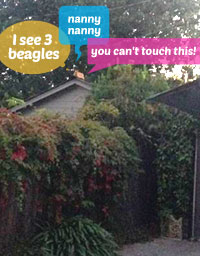 When things are calming down at night and my son is ready for his nightly bath, Buster begins his next favorite activity, which is teasing the neighborhood beagles. He climbs on our neighbor’s rooftop to wait for the beagles to notice his presence. Once they do, Buster’s fun begins. As the poor beagles go crazy running back and forth barking, Buster very condescendingly stares down at the beagles as if to say, “You can’t touch this”! If he could stick out his tongue and say “nanny nanny” he sure would. It’s not only beagles he teases, it’s any dog that he feels deserves a little torment. He will sit on fences or in front of windows in our neighborhood and watch these poor little dogs go crazy barking in an attempt to get a piece of Buster, which will never happen. I can almost see a smug grin on his face when he is home for the evening after a successful night of canine teasing.
When things are calming down at night and my son is ready for his nightly bath, Buster begins his next favorite activity, which is teasing the neighborhood beagles. He climbs on our neighbor’s rooftop to wait for the beagles to notice his presence. Once they do, Buster’s fun begins. As the poor beagles go crazy running back and forth barking, Buster very condescendingly stares down at the beagles as if to say, “You can’t touch this”! If he could stick out his tongue and say “nanny nanny” he sure would. It’s not only beagles he teases, it’s any dog that he feels deserves a little torment. He will sit on fences or in front of windows in our neighborhood and watch these poor little dogs go crazy barking in an attempt to get a piece of Buster, which will never happen. I can almost see a smug grin on his face when he is home for the evening after a successful night of canine teasing.
He is a great cat and a great companion for my family. We are lucky to have such a wonderful kitty!
The post Buster Posey appeared first on Friends of the Palo Alto Animal Shelter.
]]>The post Star Crossed Lovers appeared first on Friends of the Palo Alto Animal Shelter.
]]>Every day Sophie walks over to Jasper’s house and gazes at him through his window. Jasper settles close to the window and follows Sophie’s every move with his large green eyes. They would love to be together, but that is not allowed, so they are left gazing adoringly through a barrier of glass.
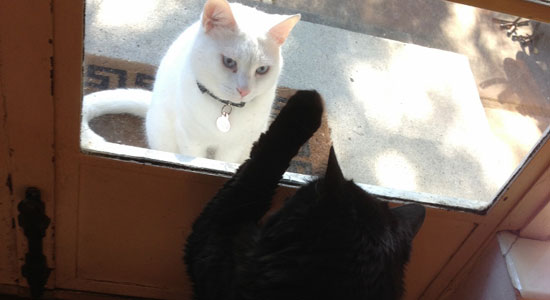
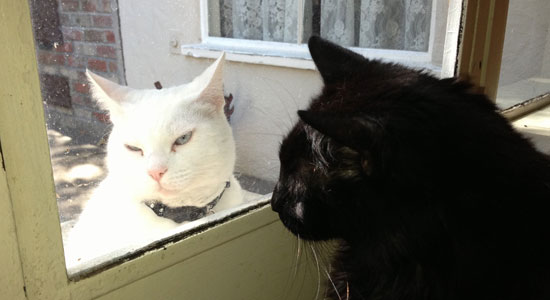
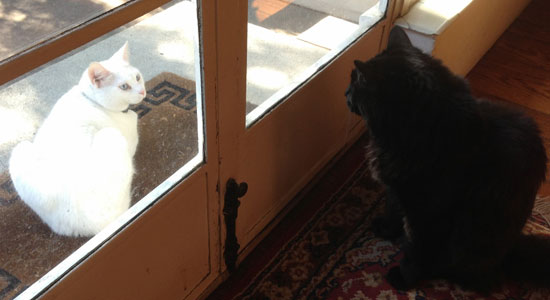

 About the Photographer
About the PhotographerJeremy Lindston Robinson, our Vice President
The post Star Crossed Lovers appeared first on Friends of the Palo Alto Animal Shelter.
]]>The post Declawing Q ‘n’ A appeared first on Friends of the Palo Alto Animal Shelter.
]]>Is declawing painful to my cat?
YesIt is not like getting a nail trim or a manicure. Declawing your cat is equivalent to chopping a human’s fingers and toes off at the first knuckle. That hurts. Your cat will be in pain after he wakes up from the surgery, and the pain will continue for a long time, perhaps even for the rest of his life. Your cat’s claw can continue growing inside the paw, which becomes extremely painful.
Does declawing maim my cat?
YesLike a human who has had their toes chopped off, a cat must relearn how to walk and balance. This relearning process is straining to the muscles. In addition, common complications during the surgery include permanent nerve damage, skin disorders, and painful scar tissue formation and bone chips (which require additional surgery).
My cat stays indoors. Does he really need his claws?
YesClaws are your cat’s first line of defense. Even if you keep your cat indoors, there is always the possibility that he might slip through the door when you’re juggling four bags of groceries and your kid’s hyperactive playmate. If your declawed cat were ever to accidentally find himself outdoors, he would be easy prey for wildlife and stray dogs and cats. In addition, cats scratch as a form of exercise and playing. Depriving your cat of this natural exercise causes muscle deterioration.
But I have a baby and don’t want my cat to scratch him. A declawed cat is safer for my baby, right?
WrongSince claws are your cat’s first line of defense, robbing him of his claws causes him to feel very insecure. This insecurity often leads to aggression, unpredictability, and shyness. Declawed cats are more likely to bite your baby in self-defense (pudgy, flailing baby arms might seem harmless, but it hurts when your cat accidentally gets bopped in the nose!). Not only that, but declawed cats must resort to other means to mark their territory. This means that your cat is more likely to urinate and defecate outside of the litterbox. Not only will you be on diaper duty, you’ll have to clean up after your cat before your baby finds a “tasty treat.”
But declawing isn’t illegal, right?
Declawing is illegal in almost two dozen other countries, including Australia, England, and Japan, because it is viewed as horridly unethical. Although it’s not illegal in the USA, it’s widely seen as an atrocity, especially by veterinarians. Most vets refuse to perform the procedure because they consider it so unethical.
But I don’t want my cat destroying my furniture. Isn’t declawing my only option?
No
The main part of the claw that snags upholstery is the sharp, curved tip. Trimming your cat’s nails regularly will protect your furniture from serious damage. When your cat is calm and relaxed, gently squeeze his toes until his claws unsheath. Using cat nail clippers, trim off the tip of the nail, careful not to trim as far as the dark vein running through the claw, or the “quick.”
Along with regular trimmings, buying a few scratching posts will allow your cat to scratch his heart out without scratching to the heart of your sofa. Simple cat scratchers start at just around $5, but if you want something that will look classy in your living room, you can pamper your cat with scratchers like these:
I bought my cat a great cat scratcher, but he still scratches my couch instead. Is it time to declaw him?
NoDo not think of declawing as an alternative, or even as a “last resort.” Declawing is inhumane and absolutely avoidable. There are numerous ways to train your cat to only scratch his cat scratcher. One scratcher usually isn’t enough, so consider buying multiple (different kinds) of scratchers. Locate one near the sofa (or wherever your cat likes to scratch), and one near his bed (the morning routine cat stretch includes scratching). Make the scratcher a fun place: play with your cat there and sprinkle catnip, or even cat treats, on the scratcher. Never discourage your cat from scratching the sofa by physical force. Instead, deter your cat with a loud voice when he scratches the sofa. You can also put double-sided tape on “scratch-free zones,” or spray the area with a lemon scent (cats don’t like citrus). If your cat still refuses to break old habits, you can spray his back with lukewarm water when he goes for your sofa (however, do not spray kittens with water, as this is very traumatizing for them).
Will my cat still love me if I declaw him?
NoAnd isn’t that all that really matters?
 About the Author
About the AuthorJoanna Tang, our Youth Board Liaison from Gunn High Scool
Photo Credit: Steve Jurvetson
The post Declawing Q ‘n’ A appeared first on Friends of the Palo Alto Animal Shelter.
]]>The post The Perks of Being an Indoor Cat appeared first on Friends of the Palo Alto Animal Shelter.
]]>The main argument against keeping cats indoors is that people feel guilty about “trapping” their cats inside and not letting them enjoy the “freedom” of the outdoors. First, let’s examine all the risks of letting your cat “experience the outdoors.”
Indoor cats live an average of 7-15 years longer than outdoor cats. Some of the main life-threatening risks to life outdoors include being run over by cars and other traffic, ingesting poisons like pesticides, acquiring diseases from other cats, animals, and parasites, being attacked or getting into a fight with other cats, dogs, and wild animals, being susceptible to animal abusers, getting lost (which often leads to starvation), and even — gasp! — abandoning your house for your friendly neighbor’s home (OK, that last one’s not life-threatening for the cat, but it might be life-threatening for you, the broken-hearted).
Aside from the innumerable dangers the outdoors poses to your cat, your cat also poses many dangers to the outdoors. Outdoor cats kill birds and small wildlife (though most do not consume their prey, as there’s a tasty bowl of kibble waiting at home). An estimated hundreds of millions of birds are killed every year by outdoor cats, and these victims often end up massacred at the owner’s bloodstained doorstep, right before you’re settling down to enjoy dinner. Cats also chew up neighbor’s plants, and can generally cause a nuisance by clawing outdoor furniture, screens, and other pets and animals. Cats might also put you on your neighbor’s bad list by scent marking, urinating, and leaving feces on their new lawns, as well as yowling incessantly. And don’t even think about feeding your cat outdoors — cat food attracts other outdoor pets, as well as potentially dangerous wildlife like mountain lions and foxes.
As you can see, the cons heavily outweigh the pros of being an outdoor cat. Yes, cats like sniffing grass and chasing bugs. But the truth is, your cat’s curiosity of nature can be satiated inside the safety of your house. Providing plenty of indoor stimulation for your cat, like broad windowsills or window perches where your cat can see the great outdoors, screened windows so that your cat can smell the scents of nature, scratching posts, a variety of fun toys (see these Amazon lists for ideas: Best Rated Cat Toys and Supplies by Serena and Best Interactive Cat Toys ), comfy beds, plenty of human interaction, or even a feline playmate, will make the indoors your cat’s paradise. You can even grow a patch of potted cat grass for your kitty to munch on. Your cat will be completely happy indoors, and they’ll be safe, too!
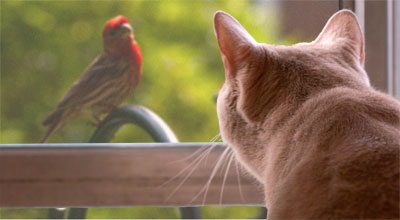 If you simply can’t stand the thought of “confining” your cat to life indoors, there is a safe solution: outdoor cat enclosures. Now, you don’t have to invest in thousands of dollars of chicken wire and get your enclosure on an Animal Planet episode about “The Most Outrageous Outdoor Enclosures.” You can start with a simple guinea pig cage, or an outdoor bunny fence with the top covered with secure towels or some spare plywood. Once you realize you have to pamper your cat even more, you can buy cat enclosures like these . Or, you can build your own .
If you simply can’t stand the thought of “confining” your cat to life indoors, there is a safe solution: outdoor cat enclosures. Now, you don’t have to invest in thousands of dollars of chicken wire and get your enclosure on an Animal Planet episode about “The Most Outrageous Outdoor Enclosures.” You can start with a simple guinea pig cage, or an outdoor bunny fence with the top covered with secure towels or some spare plywood. Once you realize you have to pamper your cat even more, you can buy cat enclosures like these . Or, you can build your own .
As you can see, there are plenty of safe alternatives to letting your cat roam outdoors. From window perches to outdoor cat enclosures, you can keep your cat both happy and healthy! Indoor life is the way to go when thinking of your furry friend’s safety and happiness.
 About the Author
About the AuthorJoanna Tang, our Youth Board Liaison from Gunn High Scool
Photo Credit: Derrick Coetzee
The post The Perks of Being an Indoor Cat appeared first on Friends of the Palo Alto Animal Shelter.
]]>The post How to Introduce a New Cat to the Resident Feline appeared first on Friends of the Palo Alto Animal Shelter.
]]>Because cats are naturally solitary animals (i.e. they’re not pack animals like dogs), they don’t automatically jump for joy at the prospect of a new playmate. Cats are also very territorial — let’s face it, they’re the master of your household — everything in your house belongs to them, and they can become quite aggressive if someone “invades” their space. If another feline was simply dropped onto their floor, expected to eat out of their dishes and use their litterboxes, the resident cat will see the new feline as a threat, an enemy that must be taught a serious lesson. You, the owner and protector, must also pay for allowing the new feline into its territory. Thus, the resident feline may resort to provoking fights with the newcomer, as well as spraying territorial urine markers around the house. To prevent mayhem from breaking out in your duo-feline house, follow these steps carefully and without haste:
Step #1: Bringing the Newby Home
Before you bring your new kitty home, prepare a separate room for it, complete with food and water dishes, a litterbox, a bed, and some toys. Bring your new cat directly to this room and keep the door closed. In this room, your new cat can relax and reorient itself. Meanwhile, your resident cat will know that something is behind that closed door, and will be curious rather than feel threatened.
Step #2: Scent Swapping
Scent swapping allows both cats to recognize each other without feeling intimidated by each other’s presence. Place a towel in each cat’s bed or by their food dishes for a day. The next day, swap the towels, putting each cat’s scent-covered towel by the other’s food bowls. If you notice either cat avoiding their food or even hissing at it, move the towels a little further away from their food bowls. Then, gradually move the towels closer to their food bowls until both cats are comfortable eating with each other’s scent present. Consider swapping the cats’ bowls, or even rubbing each cat’s cheeks (where “friendly” hormones are secreted) with a towel and swapping these. This process may take days, or even weeks. Make sure both cats are completely comfortable in the presence of the scent towels.
Step #3: Seeing Each Other for the First Time
After successful scent swapping, it’s time for the cats to see each other. However, they should not have full physical contact. The door of the new cat’s room should be barred with a screen or baby gate (or simply crack the door open so that the cats can see each other touch noses, and secure the door with a nail and rope). This way, the cats can sniff each other out, but no one can start a brawl. Begin feeding the cats closer and closer to the door, until you are absolutely certain that the cats feel comfortable with each other. If there are hisses, spitting, growling, or raised hackles, go back to Step #2.
Step #4: Happily Ever After
Only after each cat shows no signs of aggression and seems comfortable sniffing and rubbing the other can the screen/baby gate be removed. Make sure to watch the cats as both have free range of the house, putting the new cat back into its room if there are signs of aggression. Make sure each cat has its own food and water bowls, litterbox, and bed. It is normal for one cat to come out as the “alpha” cat, so you might notice that one cat (usually the resident cat) always eats first, and that the other follows the alpha cat around the house. However, if the alpha cat begins to hiss and swat at the other cat (particularly around food dishes), make sure that the other cat has its own dishes, litterbox, and bed away from the alpha cat’s.
Following these four easy steps will allow your cats to become fast friends. They will be great playmates and entertainment for each other, and will be double the cuteness for you to enjoy!
 About the Author
About the AuthorJoanna Tang, our Youth Board Liaison from Gunn High Scool
Photo Credit: laurelrusswurm
The post How to Introduce a New Cat to the Resident Feline appeared first on Friends of the Palo Alto Animal Shelter.
]]>



